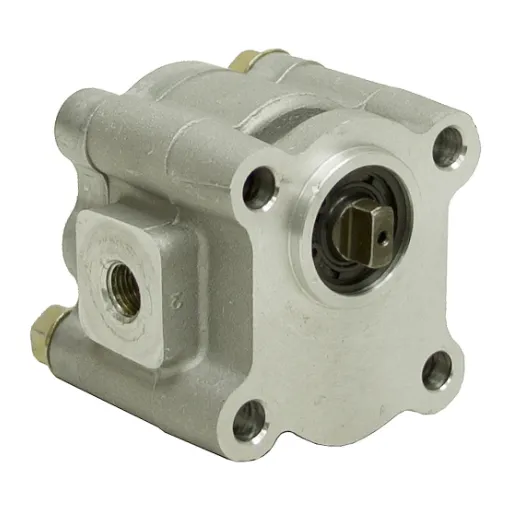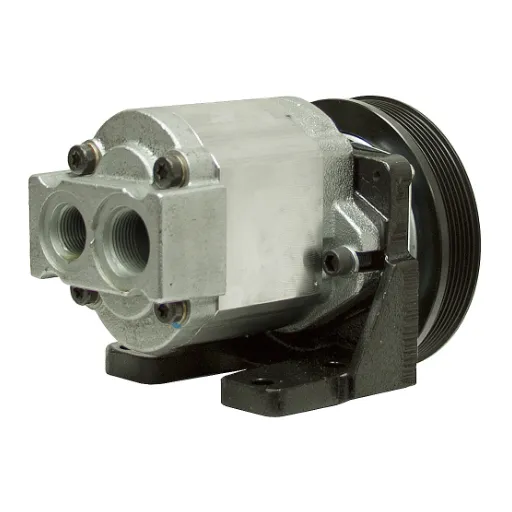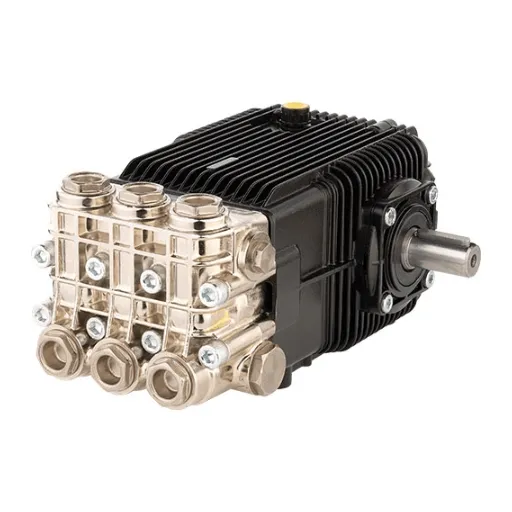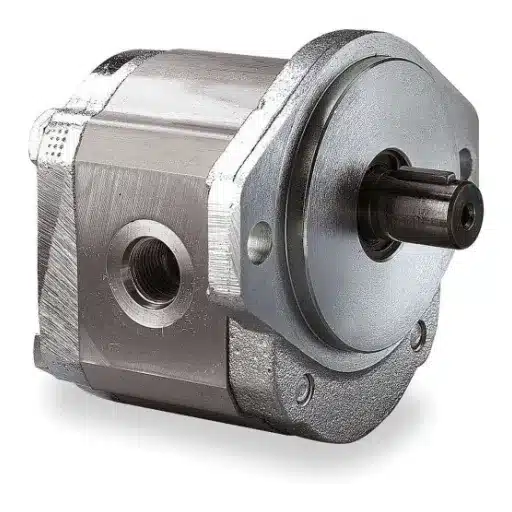Rotary vane pumps are critical components in a wide range of industrial, commercial, and scientific applications, providing efficient and reliable performance in both hydraulic and vacuum systems. This comprehensive guide will explore the fundamental principles of rotary vane pumps, their design and operational mechanics, and the various roles they play in modern technology. By delving into their key features, benefits, and use cases, this article aims to equip readers with a detailed understanding of these versatile machines. Whether you are an engineer, technician, or industry professional, this resource is designed to provide authoritative insights into the functionality, maintenance, and potential of rotary vane pumps in diverse settings.
What Are the Types of Vane Pumps Available?

Hydraulic Vane Pumps: Applications and Advantages
Vane pumps in the hydraulic style find wide applications in fluid power systems because of their ability to produce consistent flow with high efficiency. These pumps are multifaceted and are used in industrial machinery, automotive systems, or even aerospace equipment that require dependable hydraulic power.
- Operating Pressure: Typically falls between the ranges of 1000 psi and 4000 psi depending on the specific design and model.
- Flow Rate: Usually between 1 GPM (gallons per minute) to 300 GPM suited for a wide spectrum of applications.
- Efficiency: Their volumetric efficiency is said to be high, often greater than 90%, which is remarkable.
- Speed: Effectively works within a speed range of 600 RPM to 3000 RPM.
Other benefits include low noise during operation, thanks to the internal design on top of moderate contamination levels allowed in the hydraulic fluid. Other than these, the pumps are durable and require low maintenance, which is an advantage for all users.
Rotary Vane Vacuum Pumps: Exploring Their Unique Features
Rotary vane vacuum pumps are known for their efficiency and multiplication in applications that require a high level of vacuum mechanical work over a long duration. This type of pump consists of a motor that drives a series of blades on a rotor, which turns inside the pump housing. The vanes reciprocate relative to the rotor and are kept in sliding contact with the casing of the pump, forming compartments of different sizes that facilitate continuous unmolding and molding of gas.
- Ultimate pressure: Normally gets to level of 0.5 mbar (abs) which is acceptable for most industrial work and laboratory jobs.
- Pressure range: Depending on the model, unit can work with flow rate of 5 m3/h to over 1000m3/h.Practical range to suit operations of different size.
- Energy Efficiency: Has low energy cost in regardless of quantity of work, improved with application of modern motor construction.
- Oil Lubrication: The Stable performance and sealing efficiency of the pump are greatly enhanced by the proper mechanism of wear parts being sealed by oil.
Rotary vane pumps have the best pricevalue ratio in terms of operational life and guaranteed degree of vacuum. Used in packaging, medical instruments and HVAC systems, but also in harsh conditions such as semiconductor manufacturing and research labs. They are small and easy to maintain making them last long and adding practicality.
Flexible Vane Pumps: When and Where to Use Them
Flexible vane pumps fit perfectly in situations that need self-priming, constant flow rate, and the ability to process both thick and thin liquids. These pumps can capture solid particles and gentle fluids without damaging them due to their operational mechanism of flexible vanes creating suction and discharge. Therefore, these pumps are well suited for food and beverage processing, chemical transfer, and marine industries.
- Flow Rate: Can range from 1 to 250 GPM based on the size and arrangement of the pump.
- Pressure Capacity: Functions perfectly at a pressure of 150 PSI or less, which is the case in many industrial and commercial environments.
- Viscosity Range: It is Able to process fluids with viscosities from 1 to 20,000 cP, which includes oils, syrups, solvents, and a plethora of others.
- Temperature Tolerance: Can withstand extreme cold and hot temperatures, typically ranging from -40°F to 300°F.
- Material Compatibility: Made from stainless steel as well as reinforced polymers which enables resistance to corrosion and deterioration due to chemicals.
These pumps are especially useful where sharp focus and strength are required. The different conditions under which these pumps can, and do, work with great precision causes them to be reliable and efficient in many different settings. This flexibility makes flexible vane pumps a versatile solution and is evidenced across many industrial sectors.
What Are the Advantages and Disadvantages of Vane Pumps?

Benefits of Using Vane Pumps in Various Industries
Vane pumps are a popular option for a variety of industries because of the many benefits they offer. First and foremost, they offer superior volumetric efficiency defined by low internal leakage and the ability to sustain a steady flow rate at diffident pressures. This is very important for hydraulic systems, where there is a need to control the movement of fluid very accurately. Also, their noise level is lower than other pump types which improves working conditions in difficult environments.
Their self-priming feature is another significant advantage. Vane pumps are perfectly suited to the automotive, food processing, and chemical manufacturing industries since they can maintain an even flow of low-viscosity fluids. They thermally scale in perfomance too which means they can achieve the flow rates of 0.1 GPM (gallons per minute) to more than 250 GPM, while typically, they endure pressures of around 300 PSI.
Furthermore, vane pumps are constructed from materials that resist abrasion, giving them a long service life in even the most demanding situations. They also have good suction capabilities, which makes them suitable for high lift or long suction line applications. Finally, the modular design guarantees effective maintenance and parts replacement throughout industrial work, which minimizes downtimes.
All of these reasons, as well as the ability to function in many different conditions, emphasize the great advantages that vane pumps offer in many industries.
Limitations and Potential Drawbacks of Vane Pump Technology
Even though vane pumps have a range of benefits, they do have some disadvantages. Firstly, they usually do not have high pressure capabilities as compared to gear or piston pumps, so they are not effective at high-pressure ranges above 300 bars. Operating pressures of 50 to 200 bars for vane pumps seems effective, but not in comparison to other pumps.
Additionally, vane pumps are very sensitive to the cleanliness and viscosity of the fluid. As with all pumps, dirt and high fluid viscosity will greatly reduce the effectiveness, efficiency, and lifespan of the pump, but is more detrimental to these pumps. These pumps do operat best at low and moderate viscosity fluids, but also require strict filtration standards to not lead to unwanted contamination.
Another point of concern regarding case differences to electric motors would have to take into consideration both extremes of operational range. Extreme temperatures that are borne by these effectively start at -20 degrees Celsius and go to 80 degrees Celsius. At those ranges, seal breakdown, bone fatigue, or other material damages can emerge.
These limitations can be resolved by properly choosing the vane pumps to specific operational needs, matching the fluid system with proper handling, and scheduling maintenance work regularly to maintain operational effectiveness.
How Do Vane Pumps Compare to Other Pump Types?

Vane Pumps vs. Centrifugal Pumps: A Comparative Analysis
From what I know, vane pumps and centrifugal pumps have different purposes. Their differences stem from the way they work and their technical features. Vane pumps have a positive displacement system, which means that the delivery flow will remain constant regardless of changes in the pressure. This optimization makes them fit for applications that need a stable flow, such as hydraulic systems or fuel transfer. Unlike centrifugal pumps, which are considered dynamic and rely on kinetic energy to push fluids using electricity, their flow rate is also dependent on system pressure. They can only move liquids that have a low viscosity and, therefore, are used in the distribution of water or cooling systems.
- Flow Rate: The estimated steady flow of vane pumps is around 10-100 GPM (gallons per minute), while centrifugal pumps can surpass 5000 GPM.
- Pressure Range: Vane pumps tend to have higher effectiveness on higher pressures with the maximum being set to 3000 PSI. This is unlike centrifugal pumps which are only effective with very low pressures that go below 200 PSI.
- Fluid Viscosity: Vane pumps can serve the purpose of moderate to high-viscosity fluids best, while centrifugal pumps are ideal for low viscosity liquids.
- Efficiency: In cases of variable pressure, vane pumps are efficient, while with pressure changes, centrifugal pumps tend to lose efficiency.
In summary, the selection of vane or centrifugal pumps depends on the operational needs, for instance, flow variation, the pressures that can be handled, and the nature of the fluid.
Rotary Vane vs. Other Positive Displacement Pumps
The differences between rotary vane pumps and other positive displacement pumps in terms of flow rate consistency, pressure handling, and fluid viscosity range are as follows:
- Flow Rate and Consistency: In comparison to other pumps, rotary vane pumps provide a consistent, pulse-free flow, making them favorable for precise applications. On the other hand, diaphragm pumps and gear pumps may severely fluctuate due to their mechanical nature.
- Pressure Handling: As opposed to screw pumps, rotary vane pumps handle moderate amounts of pressure efficiently up to 300 PSI. Screw pumps are better suited when the application requires higher amounts of pressure such as 500 PSI.
- Fluid Viscosity Range: Vanes work well in higher to moderate viscosity fluids, making them more versatile for lubricating fluids. Compared to peristaltic pumps, vane pumps are more efficient at medium viscosities, but peristaltic pumps are better at pumping extremely abrasive, high-viscosity fluids.
- Maintenance and Durability: Rotary vane pumps are reliable long term but do require more routine maintenance when it comes to the vanes and internal parts. Gear pumps have longer life expectancies, but can become less efficient due to wear overtime.
- Pumps: Volume Efficiency and Leakage Rotar Vanes have great volumetric efficiency and internal leakage compared to lobe or piston pumps that may have higher efficiencies but lags in volumetric efficiency. Piston pumps also work over a broader range of conditions. With their higher clearances, it is much easier for them to operate.
Rotary vane pumps are technically mid-range pressure and mid-range viscosity optimized. Their steady and stable flow rate,s along with their efficient operationg enables their use in various high need precision and reliability industries such as aerospace and automotive, HVAC, fuel oil transfer, and chemical manufacturing. Their design also provides more room for mechanical simplicity, which is coupled with adaptability as compared to other positive displacement techniques.
What Maintenance is Required for Vane Pumps?

Common Wear Issues and How Vane Pumps Self-Compensate
Like other mechanical systems, vane pumps have issues with typical wear characteristics that include problems with the edge of the vane, erosion of the rotor slits, and damage to the casing surface. These typical patterns of wear result from prolonged use at higher operating pressures, employment of an abrasive or contaminated working fluid, or insufficient lubrication. Nevertheless, vane pumps, unlike most pump types, have self-compensating features that help to counter the effect of wear over time.
One important self-compensating mechanism is the centrifugal force of the vanes, which ensures that the edges of the vanes are always in contact with the pump casing cavity, albeit with some wear on the surfaces. On the other hand, the hydraulic pressure in the chamber of the pump acts on the vanes and forces them outwards, thus keeping the valve effectively closed and the volumetric efficiency intact.
- Operating Pressure Range: Standard configurations of operating pressure range is 50 to 200 psi (up to ~14 bar). Extreme pressures can cause increased deterioration of the system beyond the manufacturer’s recommendations.
- Fluid viscosity range: the best performance varies with fluids between 32 and 150 centistokes (cSt), although some models can operate with wider limits.
- Minimum lubrication requirements: The fluid must be able to maintain a minimum thickness of fluid film to avoid direct contact of the surfaces of the parts.
When properly maintained, these self-compensating mechanisms, together with appropriate maintenance, greatly improve the efficiency and reliability of vane pumps in high-demand operations by extending their operational lifespan.
Routine Maintenance Tips to Extend Vane Pump Lifespan
To ensure that the life cycle of vane pumps is maximized, it is essential to follow the schedule and process set out for their maintenance.
- Monitor Operating Pressure: Control that the operating pressure does not exceed 50 to 200 psi. Inconsistent levels of pressure can result in undue stress and further accelerate wear.
- Check Fluid Viscosity Levels: Check that the fluid viscosity is within range of 32 and 150 centistokes (cSt). Performance levels and sealing coupled with lubrication is highly reliant on viscosity levels. A too high or low value can result in both efficiency decreases as well as mechanical damage.
- Ensure Adequate Lubrication: Ensure that there is sufficient lubrication for all moving parts. Inspections should be regularly performed on fluid film thickness with a minimum allowance to prevent harsh metal contact from forming.
- Replace Worn Components Promptly: It is suggested to periodically check all the components, including vanes, seals, and bearings, for regular signs of wear. These processes suggest preemptive measures before a pump endures cumulative damage.
- Verify Alignment and Mounting: Analyze the alignment or mounting of shafts. Bad alignment in conjunction with loose mounting can lead to vibrations and noise, which causes premature failure. Check the shaft alignment tolerances. Employ precision instruments to verify that they meet the requirements.
If you follow the tips provided here and do a good job in filing maintenance records, the efficiency and lifetime of vane pumps can be greatly improved even in harsh or high-pressure conditions.
Which Industries Commonly Use Vane Pumps?

Applications in Hydraulic Systems and Fluid Power
Considering the precise control capabilities, reliability, and efficiency, vane pumps are common in fluid power systems and hydraulics. Because of its stability under pressure fluctuations, it is used in industrial machinery, automotive power steering pumps, and aerospace hydraulics pumps.
- Flow Rate: With varying application for small scale systems to large scale systems and pump sizes, a range of 5 GPM to 300 GPM is typical.
- Operating Pressure: Capable of sustaining up to 3000 PSI, which captures low and high pressure applications in heavy machinery or hydraulic presses.
- Rotational Speed: Optimal speeds in the lower range of 1800 and upper range of 600 will decrease the wear and tear while maintaining efficiency.
- Temperature Range: Using anywhere between -20°F to 250°F makes these vane pumps useful in many different environmental conditions.
These specific factors ensure that vane pumps will always be compatible with system requirements, making them reliable in important sectors that demand constant hydraulic performance.
Vane Pumps in Vacuum Technology and Process Industries
Vane pumps are particularly important in vacuum technology as well as in the process industries, where automating precise flow rates, as well as vacuum levels, is important. These pumps are commonly found in vacuum distillation, chemical processing, and food packaging. Their design is leak tight and has a minimum seal which helps in maintaining clean, sterile conditions, preventing contamination.
- Flow Rate: Adjustments of anywhere between 5 GPM to 300 GPM can be set, ensuring smooth usability in many industrial settings.
- Operating Pressure: Highly critical pressures of up to 3000 PSI are able to be sustained while having vacuum integrity. This feature is highly applicable for demanding operations such as vacuum drying or degassing processes.
- Rotational Speed: 600 RPM to 1800 RPM is the standard range. This requirement provides efficiency and reliability while minimizing maintenance issues in the long-term operation of the pump.
- Temperature Range: Functions well under a plethora of environmental and process conditions, with operational temperatures ranging from -20°F to 250°F.
With careful consideration of these factors about a system’s specifications, I am confident vane pumps will always be optimally selected and configured for their intended use. Hence, performance and reliability are enhanced in vacuum and process industry applications.
Frequently Asked Questions (FAQs)
Q: What is a rotary vane pump, and how does it work?
A: A rotary vane pump is a type of positive displacement pump that consists of vanes mounted on a rotor that rotates inside a cylindrical cavity. As the rotor turns, the vanes slide in and out, creating chambers that compress and move fluid from the inlet to the outlet. The vanes maintain contact with the pump casing, ensuring efficient operation.
Q: What are the main applications of rotary vane pumps?
A: Vane pumps can be used in various applications, including hydraulic systems, vacuum generation, and fluid transfer. They are commonly used to pump liquids containing small amounts of solids, making them versatile for industries such as automotive, manufacturing, and chemical processing.
Q: How do rotary vane pumps self-compensate for wear?
A: Rotary vane pumps self-compensate for wear through their design. As the vanes and pump casing wear over time, the vanes naturally extend further to maintain contact with the casing. This self-adjusting feature helps maintain pump efficiency and extends the pump’s operational life.
Q: What are the advantages of using a sliding vane pump?
A: Sliding vane pumps offer several advantages, including high efficiency, the ability to handle a wide range of viscosities, self-priming capabilities, and smooth, pulsation-free flow. They also have good dry-running capabilities for short periods and can operate at various speeds.
Q: Are there any limitations to using rotary vane pumps?
A: While rotary vane pumps are versatile, it is necessary to limit pump speed when handling certain fluids or in high-pressure applications. They may not be suitable for extremely abrasive materials, and the vanes may wear more quickly when pumping liquids containing large solids.
Q: How does the inlet and outlet configuration work in a rotary-vane pump?
A: In a rotary-vane pump, the inlet is typically located on one side of the pump, while the outlet is on the opposite side. As the rotor turns, it creates suction at the inlet, drawing fluid into the pump. The fluid is then compressed and expelled through the outlet on the other side of the pump casing.
Q: What happens when a vane pump is stopped?
A: When a vane pump is stopped, the vanes retract into the rotor slots due to centrifugal force no longer being present. This feature helps prevent damage to the vanes and allows for easier startup. However, it’s important to note that some pump designs may incorporate springs to keep the vanes extended when the pump is not operating.
Q: How is the shaft seal maintained in a rotary vane pump?
A: The shaft seal in a rotary vane pump is crucial for preventing leakage where the drive shaft enters the pump casing. Various sealing methods can be used, including mechanical seals, lip seals, or packing glands. Regular maintenance and inspection of the shaft seal are important to ensure proper pump operation and prevent fluid leakage.









